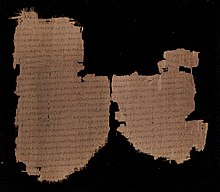Our website is made possible by displaying online advertisements to our visitors.
Please consider supporting us by disabling your ad blocker.
Gospel of Luke

| Part of a series on |
| Books of the New Testament |
|---|
 |
The Gospel of Luke[a] is the third of the New Testament's four canonical Gospels. It tells of the origins, birth, ministry, death, resurrection, and ascension of Jesus.[4] Together with the Acts of the Apostles, it makes up a two-volume work which scholars call Luke–Acts,[5] accounting for 27.5% of the New Testament.[6] The combined work divides the history of first-century Christianity into three stages, with the gospel making up the first two of these – the life of Jesus the messiah (Christ) from his birth to the beginning of his mission in the meeting with John the Baptist, followed by his ministry with events such as the Sermon on the Plain and its Beatitudes, and his Passion, death, and resurrection.
Most modern scholars agree that the main sources used for Luke were a), the Gospel of Mark, b), a hypothetical sayings collection called the Q source, and c), material found in no other gospels, often referred to as the L (for Luke) source.[7] The author is anonymous;[8] the traditional view that Luke the Evangelist was the companion of Paul is still occasionally put forward, but the scholarly consensus emphasises the many contradictions between Acts and the authentic Pauline letters (the view that the author, not necessarily Luke, met Paul is more common, perhaps including most scholars).[9][10][11] The most probable date for its composition is around AD 80–110, and there is evidence that it was still being revised well into the 2nd century.[12]
- ^ Gathercole 2013, pp. 66–71.
- ^ ESV Pew Bible. Wheaton, IL: Crossway. 2018. p. 855. ISBN 978-1-4335-6343-0. Archived from the original on 3 June 2021.
- ^ "Bible Book Abbreviations". Logos Bible Software. Archived from the original on 21 April 2022. Retrieved 21 April 2022.
- ^ Allen 2009, p. 325.
- ^ Burkett 2002, p. 195.
- ^ Boring 2012, p. 556.
- ^ Duling 2010, p. 312.
- ^ Burkett 2002, p. 196.
- ^ Theissen & Merz 1998, p. 32.
- ^ Ehrman 2005, pp. 172, 235.
- ^ Keener, Craig (2015). Acts: An Exegetical Commentary (Volume 1). Baker Academic. p. 402. ISBN 978-0801039898.
- ^ Perkins 2009, pp. 250–53.
Cite error: There are <ref group=lower-alpha> tags or {{efn}} templates on this page, but the references will not show without a {{reflist|group=lower-alpha}} template or {{notelist}} template (see the help page).
Previous Page Next Page


